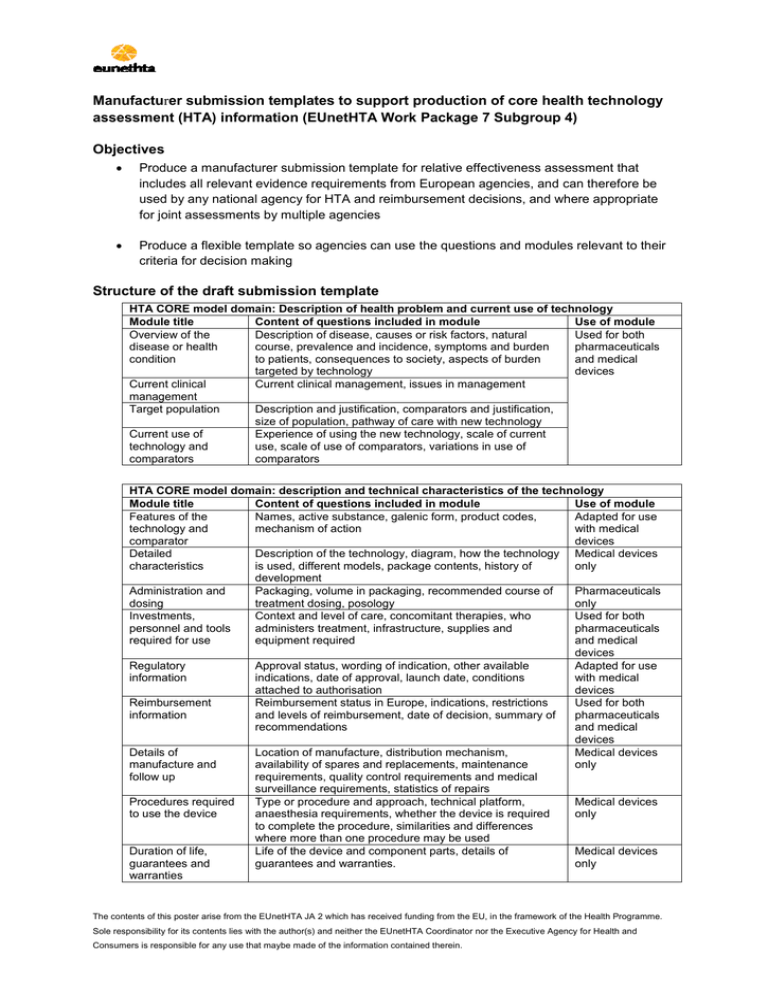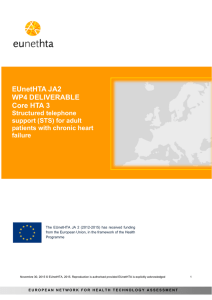Manufacturer submission templates_information leaflet
advertisement

Manufacturer submission templates to support production of core health technology assessment (HTA) information (EUnetHTA Work Package 7 Subgroup 4) Objectives Produce a manufacturer submission template for relative effectiveness assessment that includes all relevant evidence requirements from European agencies, and can therefore be used by any national agency for HTA and reimbursement decisions, and where appropriate for joint assessments by multiple agencies Produce a flexible template so agencies can use the questions and modules relevant to their criteria for decision making Structure of the draft submission template HTA CORE model domain: Description of health problem and current use of technology Module title Content of questions included in module Use of module Overview of the Description of disease, causes or risk factors, natural Used for both disease or health course, prevalence and incidence, symptoms and burden pharmaceuticals condition to patients, consequences to society, aspects of burden and medical targeted by technology devices Current clinical Current clinical management, issues in management management Target population Description and justification, comparators and justification, size of population, pathway of care with new technology Current use of Experience of using the new technology, scale of current technology and use, scale of use of comparators, variations in use of comparators comparators HTA CORE model domain: description and technical characteristics of the technology Module title Content of questions included in module Use of module Features of the Names, active substance, galenic form, product codes, Adapted for use technology and mechanism of action with medical comparator devices Detailed Description of the technology, diagram, how the technology Medical devices characteristics is used, different models, package contents, history of only development Administration and Packaging, volume in packaging, recommended course of Pharmaceuticals dosing treatment dosing, posology only Investments, Context and level of care, concomitant therapies, who Used for both personnel and tools administers treatment, infrastructure, supplies and pharmaceuticals required for use equipment required and medical devices Regulatory Approval status, wording of indication, other available Adapted for use information indications, date of approval, launch date, conditions with medical attached to authorisation devices Reimbursement Reimbursement status in Europe, indications, restrictions Used for both information and levels of reimbursement, date of decision, summary of pharmaceuticals recommendations and medical devices Details of Location of manufacture, distribution mechanism, Medical devices manufacture and availability of spares and replacements, maintenance only follow up requirements, quality control requirements and medical surveillance requirements, statistics of repairs Procedures required Type or procedure and approach, technical platform, Medical devices to use the device anaesthesia requirements, whether the device is required only to complete the procedure, similarities and differences where more than one procedure may be used Duration of life, Life of the device and component parts, details of Medical devices guarantees and guarantees and warranties. only warranties The contents of this poster arise from the EUnetHTA JA 2 which has received funding from the EU, in the framework of the Health Programme. Sole responsibility for its contents lies with the author(s) and neither the EUnetHTA Coordinator nor the Executive Agency for Health and Consumers is responsible for any use that maybe made of the information contained therein. HTA CORE model domains: clinical effectiveness and safety Module title Identification and selection of studies List of relevant studies Details of the characteristics of studies Individual study results for clinical effectiveness Individual study results for safety Risk of bias study level (randomised studies) Risk of bias study level (observational studies) Risk of bias outcome level Methods of evidence synthesis Conclusions on clinical effectiveness Conclusions on safety Subgroups Strengths and limitations Manufacturer vigilance data Safety risk management Content of questions included in module Research question, databases and registries, search dates, search strategies, inclusion and exclusion criteria, flow chart, methods for identifying ongoing and unpublished studies, citation hits Study reference, registration name/number, conflicts of interest, study dates, study location, source of identification, references to linked publications, status Study objective, design, population, intervention, comparator, follow up, primary and secondary outcome, randomisation methods, methods blinding, methods allocation concealment, methods of analysis Sample size determination, patient withdrawal, baseline comparison, study results (including assessment measure, time point, n with event, n without event, mean, standard deviation, difference, confidence interval, p value) Exposure, discontinuation and withdrawal of treatment, number of adverse events, susceptible patient groups Randomisation sequence, allocation concealment, blinding, complete outcome reporting, other aspects of bias Use of module Used for both pharmaceuticals and medical devices Determination of treatment group, baseline comparability, minimisation of bias, complete outcome reporting, intention to treat (ITT) implementation, other aspects of bias Blinding of outcome assessor, ITT implementation, complete outcome reporting, other aspects of bias Type of synthesis, outcomes in synthesis, justifications, methods used for synthesis, heterogeneity, consistency, publication bias, sensitivity analyses Relative effects on mortality, morbidity, management, quality of life, satisfaction Harms (absolute and versus comparator), dose relationship, onset, changes over time, susceptible group data Characteristics, justification, plausibility, analysis methods, results Internal validity, relevance of evidence base to scope, factors influencing external validity List of incidents, corrective measures, recalls, modifications, methods of optimising or limiting service to minimise risk Methods of optimising or limiting service to minimise risk, changes to marketing authorisation as a result of safety, other harms appearing after granting of marketing authorisation Medical devices only Pharmaceuticals only Next steps The first draft of the templates is being piloted in EUnetHTA relative effectiveness assessments and in one national process. A targeted consultation with national agencies and other stakeholders will take place from January 2015. Agencies will be asked to validate the information included in the data extraction for their agency and to comment on the draft template. Final templates will be available on the EUnetHTA website from October 2015 onwards. Contact: Zoe Garrett zoe.garrett@nice.org.uk for further details. The contents of this poster arise from the EUnetHTA JA 2 which has received funding from the EU, in the framework of the Health Programme. Sole responsibility for its contents lies with the author(s) and neither the EUnetHTA Coordinator nor the Executive Agency for Health and Consumers is responsible for any use that maybe made of the information contained therein.



